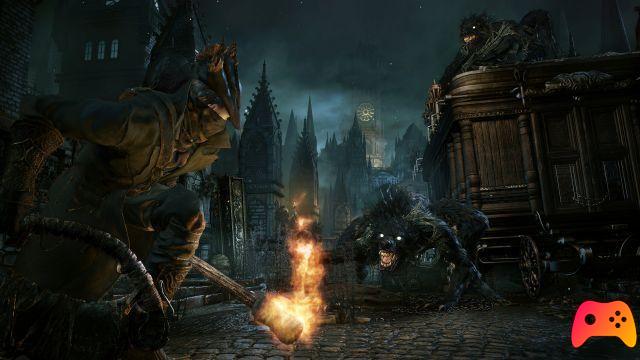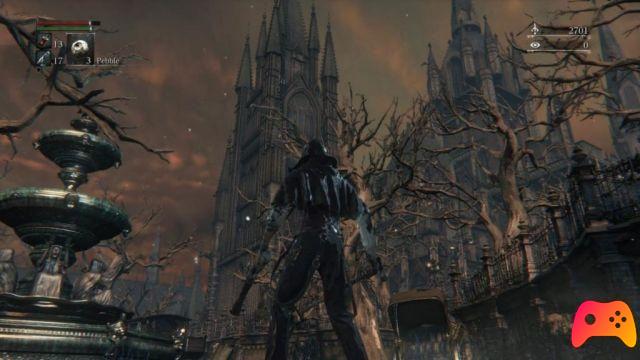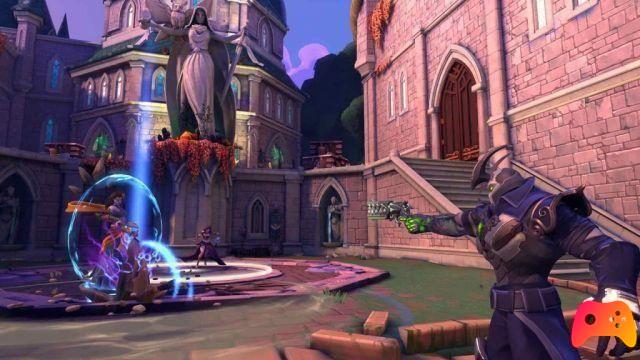
Review for Bloodborne. Game for PlayStation 4, the video game was released on 24/03/2015 The version for PlayStation 4 came out on 26/03/2015
There are titles that, alone, represent a generation of videogame platforms, products that mark a clear and precise evolution from the past. Generally they are developed only at a certain distance from the release of the reference videogame platform, when programmers have reached that confidence with the hardware capable of finally creating an excellent, unique title, very different from the usual remake. Titles like Final Fantasy VII, Sonic, Uncharted 3 alone are worth the purchase of the host platform.
Despite the amount of excellent products, most of them cross-platform, there was so far the lack of a title capable of giving the PlayStation 4 the leap forward it has been missing until now. The Sony flagship, after a first year full of remakes almost exclusively (although excellent, see The Last Of Us Remastered and Tomb Raider), only now manages to have an exclusive title capable of showing its potential so far latent.
In a videogame landscape now almost saturated with products more oriented to satisfy the masses rather than to achieve excellence, From Software represents one of the few fixed points. After its debut with the excellent Demon's Souls, which alone rewrote the rules of action RPG, marrying it to hardcore mechanics from the videogame school of the 80s and 90s, the Tokyo company has increasingly consolidated its reputation as a software house aimed at a small but very loyal circle of enthusiasts. Fame confirmed by subsequent titles (Dark Souls 1 and 2, with the related expansions) which have each time filed down the defects of the previous episodes, while increasing their strengths and ideas.
In the wake of this well-established franchise, which has also inspired dignified titles such as Lords Of The Fallen, this is finally the Sony flagship. Bloodborne, with which From Software confirms once again its intention of never wanting to give in to the rules of the market, but to continue in its personal vision of videogame excellence.
A title preceded by an expectation that has rarely been seen even in the past, albeit excellent, of the saga (also thanks to the return of Hidetaka Miyazaki to the reins of the franchise) and that does not betray the expectations, revealing that monumental work that represents the summa of the whole From Software philosophy.
Between Lovecraft and steampunk
The plot of Bloodborne, as per From Software tradition, it is rather stingy with clues, at least initially. The city of Yharnam, which has always been known for its splendid Gothic architecture, is equally famous for offering a remedy for the most varied diseases and plagues. For years now it has been a religious destination for all travelers who go there in search of spiritual and physical comfort, and the protagonist is one of these pilgrims. On his way to the town, our adventurer finds it in the throes of a virulent, bloody and apparently incurable epidemic, which has transformed almost every form of life into disturbing and bestial aberrations hungry for death and blood.
Aid at the last moment, the protagonist will make a sort of alliance with an elderly hunter, as those who fight against aberrations are defined, and an enigmatic girl, who will prove to be indispensable in order not to succumb to the epidemic that has invaded the gothic city . Having accepted his new role as hunter, our virtual alter ego will begin his adventure between the Hunter's Dream, the only bastion of peace in a world now devastated, and the architecture of a dark, deformed and violent Yharnam. At the same time trying to understand what links may exist between the Church of the cure, which places blood at the center of its rites, and the disease that has poisoned almost every creature.
The story of Bloodborne, in line with the groove left by the previous Souls, it will have to be reconstructed by putting together its clues scattered around the city, the rare dialogues and even the descriptions of some objects, and excellently evokes the atmosphere of the worst period of the witch hunt.

To die with honor, to persevere to the end
A title with such accentuated hardcore mechanics must be able to count on a solid control system and on loose and well-studied mechanics. From Software, even in this, has accustomed us well since the days of Demon's Souls. The control system is decidedly inspired by that of the previous episodes, but it differs from it for some interesting features, aimed at rejuvenating the now saturated mechanics.
The first novelty that is noticed is undoubtedly the absence of a shield and real armor. This choice, which could disappoint the purists of the saga, is aimed at diverting the gameplay towards a style more set on fast decisions and rapid and well-studied attack patterns, effectively eliminating the mechanism, now abused, of the perennial parry / attack of the previous ones. Souls. A shield actually exists somewhere during the adventure, some enemies make use of it, but its weakness makes it a practically useless object.
The elimination of armor now allows our character to move quickly in any circumstance (except in the event that you decide to equip the heavier weapons). Furthermore, the shield has been replaced by firearms with a decisive steampunk style, which in terms of damage (however upgradeable) do very little, but which prove to be very useful for stuning enemies, provided you seize the right moment to make fire, allowing you to then perform critical hits with the white weapon.
Such a change in attack and defense mechanics denotes the developers' courage and their desire to innovate, and could very well turn into a disappointment, transforming Bloodborne in a hack'n slash as if you see too many. Without shields, without armor and (almost) without magic, the only alternative is melee, but the perfection of the control system and mechanics effectively transforms every fight into a splendid choreography based on attacks, dodges, somersaults and blows of firearm. However, paying due attention: an attack system based mainly on offensive and dodging does not mean charging every enemy head down. Even the simplest of clashes requires careful planning, necessary to study well the attack patterns of the enemies and the relative countermeasures, under penalty of premature death.
Another decisive change of course is represented by the scarcity of available weapons and armor. While not lacking a fairly wide choice of white weapons, firearms and related upgrades, we are far from the amount of equipment available in the various Dark Souls. A choice, also this, apt and deserving of having considerably streamlined the gameplay of the title.
Other novelties concern the loss of hit points, which can be partially recovered by counterattacking an enemy immediately after being wounded, and the management of blood vials, heirs of the Estus flasks, now available as an object dropped by enemies or purchased in the store (exactly like the waning grass of Demon's Souls).
In the face of a renewed attack system, we find other mechanics taken from previous episodes: to advance the level we will turn to an enigmatic female figure, emulating the Black Virgin of Demon's Souls, using Echoes of blood, equivalent of the souls of the previous ones Souls.
Upon the death of our adventurer, the accumulated experience will again be abandoned in the place of departure, with the possibility of being recovered (and permanently lost in case of further death). But with a novelty: in some situations, a wandering enemy, characterized by luminous eyes, will be able to take possession of our blood echoes, and it will be necessary to beat him in order to regain possession of our experience.
There are still some bonfires (in this case lanterns) that connect to the Hunter's Dream, where we can take a breather and increase the characteristics of our character. But the scarcity of these lanterns forces us to rely heavily on the shortcuts that connect the various elements of the scenario. Ultimately the alchemy between the control system, the architectures of the scenarios, shortcuts, secret passages and locations of the various enemies borders on perfection. One gets the impression that Yharnam is an immense dark casket, a continuous surprise to be revealed with perseverance and patience.
Patience, in fact. In spite of the initially feared possibility that the title could have a lower difficulty level than the Souls, we still find a system that requires patience, study, passion, training and perseverance to get to grips with the mechanics of Bloodborne, however complex and satisfying, in spite of the previously mentioned necessary gameplay filings. Once again every misstep allows us to improve and every death forces us to learn something new about the complex mechanics of the From Software title, which does not forgive the slightest mistake, and places the user in front of a varied, fascinating and complex world. where even the simplest situation must be deciphered almost from scratch.
The duration of our adventure is decidedly shorter than the various Dark Souls, but it is more concentrated, the mechanics are wisely studied in order to eliminate the long empty laps and the endless journeys between one scenario and another, typical of the previous episodes .
A separate discussion, again, the online sector deserves it, however linked to the obligation of an active PlayStation Plus subscription. We still find the asynchronous mode, that is the ability to read messages left by other users (and to leave them in turn) and to highlight their spectra in order to study their defeats. There is also the possibility of summoning other users, an option as always very useful especially against bosses, but with the welcome change of being able to limit the entry of other users into the field thanks to a password system. Same identical mechanics as the previous Souls, then, but you are starting to feel the lack of a real online cooperative mode.
An excellent novelty, a true cornerstone of the online experience of Bloodborne, is represented by the Chalice Dungeons. Unlockable through objects found during the main adventure, these levels represent a sort of parallel dimension to Yharnam, immense and complex dungeons able to generate randomly, including traps, enemies and new bosses. There is also the possibility to block and save our personal dungeon and share it with other users. An option that makes this latest From Software title virtually unlimited, and greatly expands its potential and longevity.
A monumental Gothic work
The technical department of Bloodborne it is what, more than any other aspect, represents a clear break with the previous titles of From Software. The polygonal models are very accurate, the visual horizon is almost unlimited, the level of texture and detail is close to excellence. One has the general impression that Bloodborne is a title able to finally represent the technical gap between the PlayStation 4 and the previous generation of videogame platforms.
Unfortunately, even the most beautiful picture has its spots: in the face of a first-rate technical sector, Bloodborne unfortunately suffers from occasional drops in frame rate and a camera that is not always perfect, indeed sometimes even bad. It is not uncommon to die more from an unhappy shot, rather than a real mistake on our part.
In the face of a still excellent technical realization, the real strength of the title, as from the From Software school, is represented by the general design. Every aspect of the title, from the enemies to the equipment, from the settings to the architecture, everything seems designed to instill a perennial unhealthy sense of decay. The happy union between the gothic atmospheres, definitely inspired by the works of Howard P. Lovecraft, and many steampunk elements, gives a general picture whose charm even surpasses that of the settings of Dark Souls. After three episodes of the franchise (and related expansions) From Software proves once again capable of giving birth to increasingly disturbing environments and creatures.
In support of so much artistic magnificence, we find an equally well-finished sound sector. As per the Souls brand, the music is quite rare, covering only some important moments of our adventure and the battles against the bosses, but it remains excellent and atmospheric. But it is on the side of the sound effects that we notice clear improvements compared to the one, albeit excellent, of the previous From Software titles: the sound effects, the laments of the enemies, the gothic bells, the distant echoes of the most distressing creatures, the steps in the dark, each sound element is treated with absolute mastery, and perfectly inserted into the context.
For the first time in the series, we also find a complete localization in the main languages, whose voice actors, which is rare in the videogame field, are quite skilled and convincing.
From Software's latest masterpiece, let's say it straight away, is a monumental work of videogame talent. Although it would have been enough to create a Dark Souls clone to still have a great product, From Software has not rested on the laurels of the previous episodes, but has reinvented its own genre. The perfect and satisfying mechanics, the unique and fascinating atmospheres, and the general design represent a sincere act of respect by From Software towards the fans of the series. The few graphics glitches and currently unacceptable loading times can easily be corrected by a patch. The novelties and the filings of the gameplay represent an excellent renewal, combined with the excellent longevity also guaranteed by the idea of the Chalice Dungeons. Bloodborne is a perfect example of how a great product should be conceived. Those who expected a simple Souls clone will have to change their minds, Bloodborne rehashes and upsets the certainties of the veterans of the saga, throwing them into a fascinating gothic nightmare from which one would never want to wake up. [/ Signoff]
► Bloodborne is an RPG type game developed by FromSoftware and published by Sony for the PlayStation 4, the video game was released on 24/03/2015 The version for PlayStation 4 came out on 26/03/2015
Our latest game news: How to find the Bloodstone in Bloodborne






